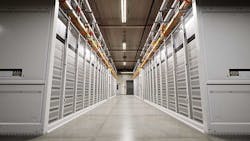Microsoft Outlines Its Vision For a Zero-Carbon Cloud, Around the Clock
This week Microsoft outlined a vision to run its Azure “planetary computer” and its 4 million servers using entirely zero-carbon sources, including hourly matching of renewable energy. Microsoft says it will work with utilities and industry partners to “lay the groundwork for a decarbonized grid.” The company also outlined plans to deploy “circular centers” to boost the recycling and reuse of IT components and create zero-waste data center campuses.
“By 2030 Microsoft will have 100 percent of our electricity consumption, 100 percent of the time, matched by zero carbon energy purchases,” Microsoft said in a blog post by Chief Environmental Officer Lucas Joppa and Noelle Walsh, CVP for Cloud Operations + Innovation. We know that our actions alone won’t decarbonize the grid, but we are committed to doing our part to help drive important market demand signals that influence the speed and scale at which the grid decarbonizes.”
Microsoft began its implementation of zero-carbon strategies last year with a new campus in Sweden that will be the company’s most advanced and sustainable to date by integrating renewable energy sources, and a new data center design. This week Microsoft outlined several steps to advance granular tracking of its energy use.
- Microsoft said it would expand its hourly energy tracking, which began last fall with a local program using a 24/7 matching program from Vattenfall for its Swedish campus. The company will add a new pilot in the Netherlands with energy provider Eneco and FlexiDAO, which will match its Amsterdam datacenter’s hourly energy consumption with Dutch offshore windfarm Borssele.
- Microsoft is enabling “spatial matching” of its energy use with data called Locational Marginal Emissions (LMEs), which tracks the condition of the power grid at the time and location that the clean energy was produced. Microsoft is partnering with REsurety We partnered with REsurety to create an LME tool on Azure that calculates the decarbonization impact of its renewable energy supply with greater accuracy, beginning first with a pilot in the Electric Reliability Council of Texas (ERCOT).
“We can play a key role in fully decarbonizing the grid,” said Brian Janous, GM of Energy and Renewables and Microsoft. “To do it the fastest and the most cost-effectively, we need to be able to understand the carbon impact of each MWh coming from a specific wind, solar, or storage plant. We want to make sure that the clean energy we’re helping to bring onto the grid has the maximum environmental benefit. REsurety’s Locational Marginal Emissions data gives us the transparency we need to make climate-wise investments.”
Microsoft becomes the latest cloud operator to commit to power its data centers around-the-clock with clean power. Last September, Google said will power its entire global information empire entirely with carbon-free energy by 2030, matching every hour of its data center operations to carbon-free energy sources.
“We’re thrilled to see another major company commit to operating on 24/7 carbon-free energy,” said Kate Brandt, Chief Sustainability Officer at Google. “There is a growing consensus from business leaders to the White House that we must move beyond emitting and compensating, and take steps to operate using carbon-free energy every hour of every day.”
Multi-tenant data center operators are also seeking to provide hourly tracking of their energy use. Earlier this year Iron Mountain began teaming with RPD Energy and Direct Energy to source 100 percent renewable energy aimed at matching the hourly usage renewable energy load of electricity used in more than 60 Iron Mountain facilities in Pennsylvania and New Jersey.
Long-Term Goal: A Decarbonized Grid
Microsoft’s announcements, which coincided with a major customer conference, covered a broad scope of sustainability initiatives. The company acknowledged that it cannot accomplish its goals alone.
“At Microsoft we have a long-term vision that we refer to as 100/100/0 – that on all the world’s grids, 100 percent of electrons, 100 percent of the time, are generated from zero carbon sources,” the company executives noted. “We call this a vision because we alone can’t control the outcome. Like other users, our datacenters and our offices around the world simply plug into the local grid, consuming energy from a vast pool of electrons generated from near and far, from a wide variety of sources. So while we can’t control how our energy is made, we can influence the way that we purchase our energy.”
Microsoft said that over the last 12 months, it has signed new purchase agreements for approximately 5.8 gigawatts of renewable energy across 10 countries around the globe. This includes more than 35 individual deals, including over 15 in Europe spanning Denmark, Sweden, Spain, U.K. and Ireland. This procurement brings Microsoft’s operating and contracted renewable energy projects to 7.8 gigawatts globally.
More Circular Centers to Reduce IT Waste
The company also said it would build additional Microsoft Circular Centers at data center campuses to pursue zero-waste policies. These facilities use machine learning to process servers and hardware that are being decommissioned onsite, boosting the percentage of components that can be reused and repurposed, and applying data to help its supply chain teams improve the sustainability of future generations of equipment.
“We expect the Microsoft Circular Centers to increase the reuse of our servers and components by up to 90 percent by 2025,” said Microsoft.
The company launched its initial Circular Center in Amsterdam, and this week it said it plans to bring new Circular Centers to campuses in Dublin, Chicago, Singapore and Boydton, Virginia in the coming fiscal year.
About the Author



